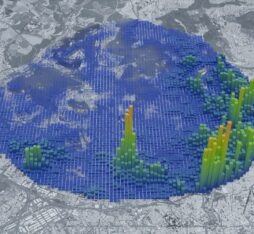“Thanks to targeting, the TV advertising market could generate an extra €200 million in turnover by 2022”
Targeted messages, which have been a major feature of online advertising for a long time, have not yet appeared on the live television market. Across any given region where Orange operates, viewers see the same commercials at the same time. The only possible ‘targeting’ is managed by the advertiser and the advertising agency, based on the programme and what time it goes out. However, it does not allow for a particular advert to be aimed at a viewer according to their profile or location. Known as ‘addressable’ or ‘segmented’ advertising, a new technique developed by Orange allows one advert in an ad break to be replaced live by another, depending on the customer’s location and socio-economic profile. The market could generate an additional €200 million in turnover by 2022 thanks to this new technology, according to the SNPTV (Syndicat National de la Publicité Télévisée — France’s national syndicate for televised advertising).
Two and a half years in development
Viewers will not notice any difference. Once they have given their consent for targeted ads, the adverts are replaced seamlessly — without any effect on the image or sound. Behind the scenes, this is a very delicate technical operation, which has required two and a half years of work in close collaboration with television channels. To be able to substitute one advert for another, the engineers had to innovate and add special, extremely precise segmentation to the TV streams, at frame level, indicating the start of the ad break, the start of the advert to be substituted, the end of the advert and the end of the break. A brand new stream segmentation standard was implemented in collaboration with all stakeholders in the industry. Interoperability between the different channels and between different operators’ TV decoders has therefore been guaranteed.
“In the solution we have implemented, the advert is replaced at the decoder level for Orange TV subscribers,” explains Gilbert Bonizec, Technical Project Manager. When an ad break starts, the decoder will query the channel’s ad-server (the advertising campaign management software) via a unicast (single-recipient) connection: “I have an ad break, do I have adverts to replace in it? If so, then which ones?” The ad-server’s response is based on current advertising campaigns and the customer’s eligibility. If there is an available advert, the advertising agency’s server will indicate to the decoder: “the 3rd advert in the break should be replaced and this ad has a specific identifier”. When the advertising message to be replaced arrives, the decoder detects it thanks to the segmentation and a switch is made at the player level between the channel stream and the new advert stored in the memory. Once the advert has gone out, the player returns to the channel’s multicast stream (multi-recipient broadcast).”
The day before a segmented advertising campaign, the television channel sends Orange the adverts that will be broadcast in a targeted manner. These are stored on the carrier’s Content Delivery Network (CDN) and retrieved by the decoder at the beginning of the ad break. The broadcaster guarantees that the substituted ads are the same length as the original ones.
Targeting in, tracking out
The decoder may be the operational part of the system, but it is an advertising agency’s ad-server that matches the customer’s targeting data with the campaigns sold to advertisers: it decides which adverts will be targeted for each TV subscriber. Meanwhile, Orange feeds this ad-server on a weekly basis with data from customers who have expressly given their consent for this.
As part of this first stage, targeted advertising is carried out on the basis of geolocation data, socio-demographic criteria (socio-professional categories, household composition) and the amount of live TV consumed in the home (substantial/moderate TV consumer). More refined targeting is planned for the next phase of the project.
The final interface between Orange and the advertising agency is that, after the targeted advert has been broadcast, the decoder will send tracking data to the partner’s platform. In this way the channel and advertiser will find out the completion rate of the message, namely whether the advert has been viewed at 25, 50, 75 or 100%.
When two universes collide…
“This project is a coming together of two worlds that had previously lived separate lives: the world of live TV and that of targeted advertising,” says Gilbert Bonizec. “Unlike other television projects where Orange takes charge from start to finish, for targeted advertising the challenge has been to interlink our solutions with those of our partners.” This technical collaboration between carriers and advertising agencies allows us to envisage new revenue streams for digital television. “Targeted advertising has the potential to combine the power of TV media, where campaigns are still more highly valued than on the Internet, and the accuracy of digital advertising,” enthuses the SNPTV.
In France, the service has been live since 8 October with 100,000 Orange Fibre customers. Incidentally, the first segmented advertising campaign in France, broadcast over the France Télévisions airwaves, is… an Orange campaign! The Group has bought slots from the France Télévisions advertising agency for this great première. From now on, the system is set to grow on a weekly basis, with a roll-out to 400,000 fibre customers at the end of October and to ADSL subscribers in November. In addition to France Télévisions, TF1 and M6 will also be involved in the coming months. To open up the French advertising market, a legislative obstacle also had to be removed: this type of advertising has only been permitted there since a decree to that effect was issued on 6 August 2020.







